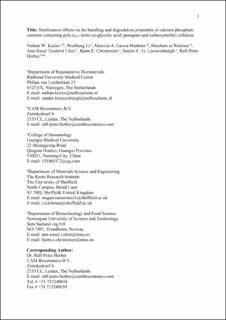Sterilization effects on the handling and degradation properties of calcium phosphate cements containing poly (D,L-lactic-co-glycolic acid) porogens and carboxymethyl cellulose
Kucko, Nathan W.; Li, Wenliang; Martinez, Marcela A. Garcia; Rehman, Ihtesham ur; Ulset, Ann-Sissel Teialeret; Christensen, Bjørn E.; Leeuwenburgh, Sander C.G.; Herber, Ralf-Peter
Peer reviewed, Journal article
Accepted version

Åpne
Permanent lenke
https://hdl.handle.net/11250/2651705Utgivelsesdato
2019Metadata
Vis full innførselSamlinger
Originalversjon
Journal of Biomedical Materials Research. Part B - Applied biomaterials. 2019, 107 2216-2228. 10.1002/jbm.b.34306Sammendrag
Injectable, self‐setting calcium phosphate cements (CPCs) are synthetic bone substitutes considered favorable for the repair and regeneration of bone due to their osteocompatibility and unique handling properties. However, their clinical applicability can be compromised due to insufficient cohesion upon injection into the body coupled with poor degradation rates that restricts new bone formation. Consequently, carboxymethyl cellulose (CMC) was incorporated into CPC formulations to improve their cohesion and injectability while poly (D,L‐lactic‐co‐glycolic acid) (PLGA) porogens were added to introduce macroporosity and improve their biodegradation rate. Like most biomaterials, CPCs are gamma irradiated before clinical use to ensure sufficient sterilization. However, it is well known that gamma irradiation also reduces the molecular weight of CMC and PLGA via chain scission, which affects their material properties. Therefore, the aim of this study is to measure the effect that gamma irradiation has on the molecular weight of CMC at varying doses of 15, 40, or 80 kGy and investigate how this affects the handling (i.e., injectability, cohesion, washout, and setting times) and in vitro degradation behavior of CPC formulations. Results reveal that the molecular weight of CMC decreases with increasing gamma irradiation dose, thereby reducing the viscosifying capabilities of CMC, which causes CPCs to deteriorate more readily. Further, the addition of CMC seems to inhibit the degree of phase transformation during cement setting while the subsequent reduction in molecular weight of PLGA after gamma irradiation improves the in vitro degradation rate of CPCs due to the faster degradation rate of low molecular weight PLGA. © 2019 Wiley Periodicals, Inc. J Biomed Mater Res Part B: Appl Biomater 107B: 2216–2228, 2019.